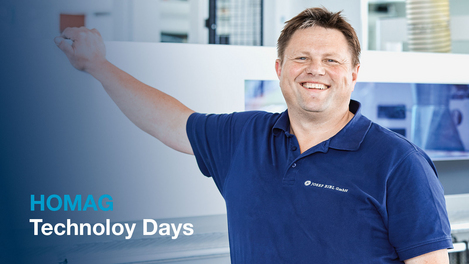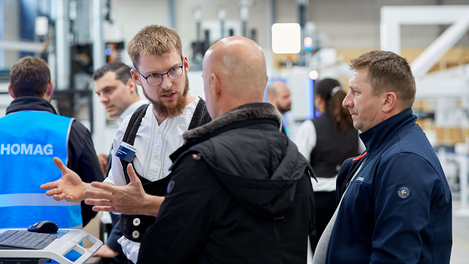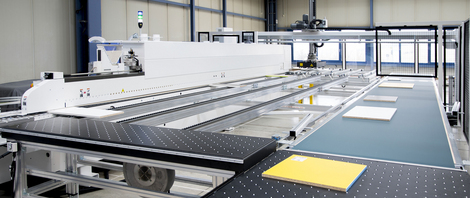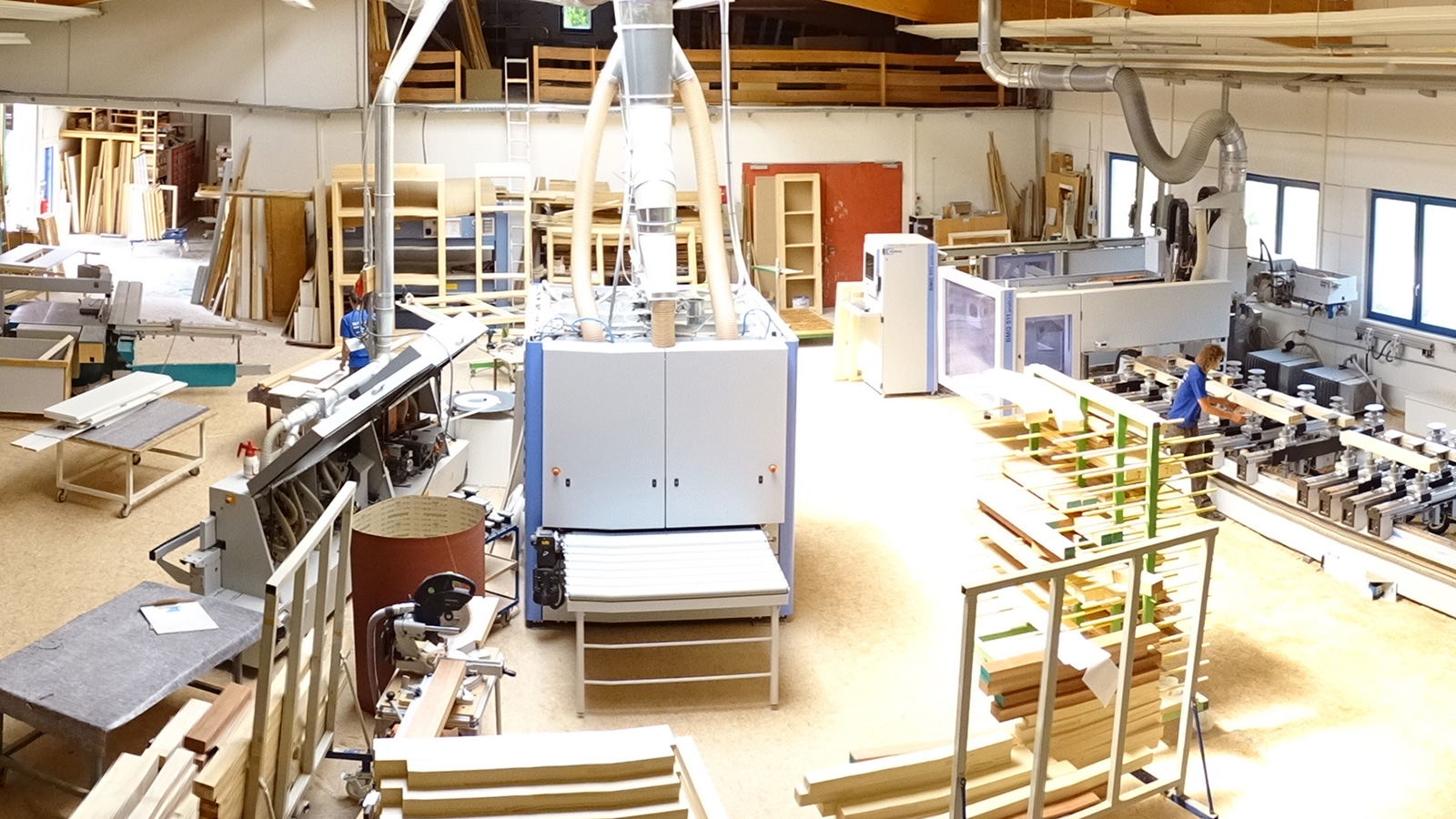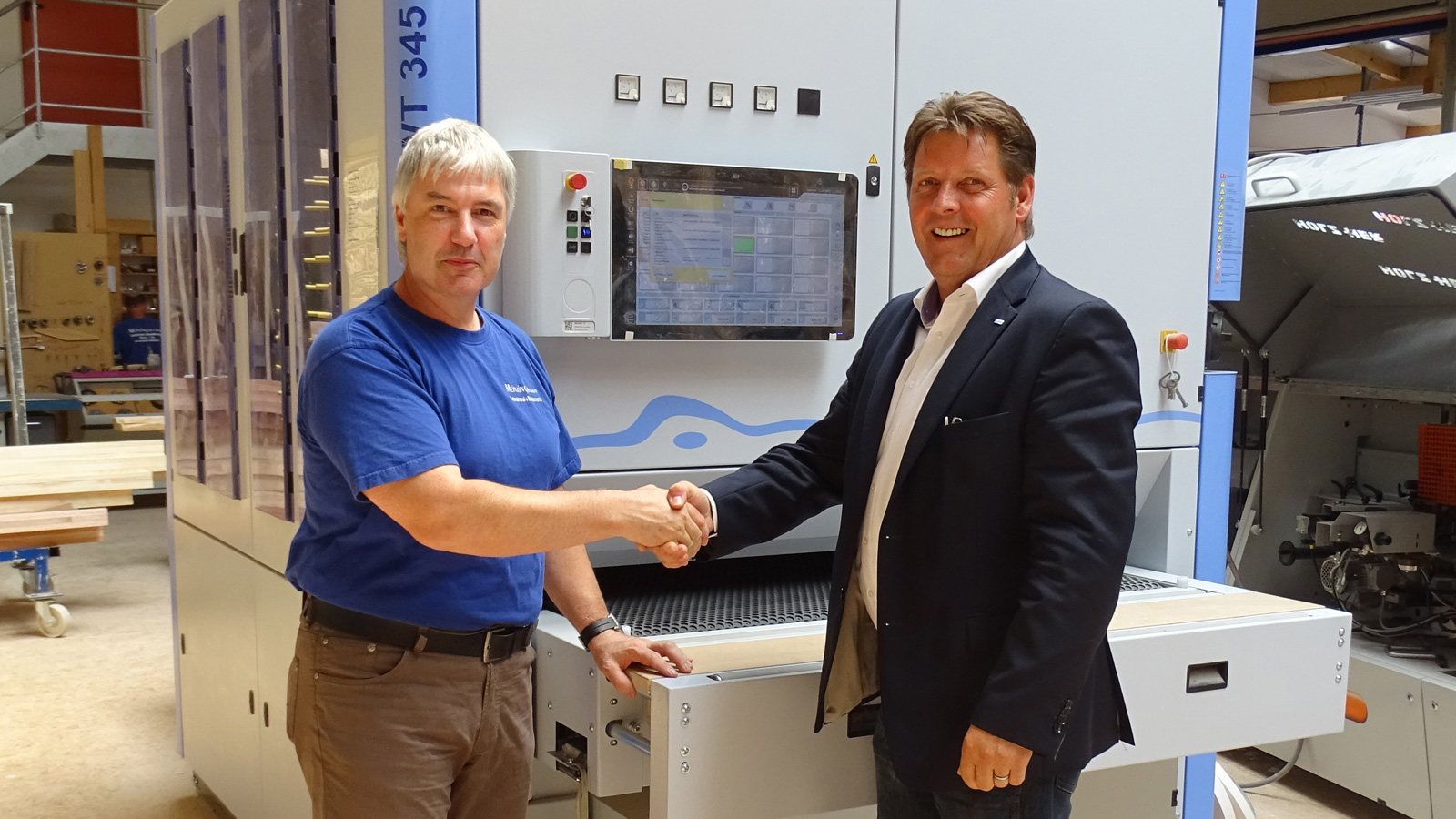Windows, doors, furniture: for decades, Meinzinger has been producing everything their customers request. The secret of his success? Honesty, the necessary know-how, and impressive trade expertise. Meinzinger's employees can do everything manually — and to the highest quality. Nevertheless, last year he invested in a new sanding machine. So what are the employees doing now? They have time for other tasks. When the managing director took the decision to buy a wide-belt sanding machine from HOMAG, he really hit the mark. When making the decision, he only had one shot — and he couldn't afford to miss.
When you step into the premises of Meinzinger in Wörth an der Donau, Germany, you are surrounded by a world of windows, stairs, and doors that would set the pulse of some architects or house builders racing. There are house doors, high-gloss or veneer internal doors, windows made from wood or wood and aluminum, and individual solutions to match design or functional needs, from traditional to elegant, from classic to modern.
You’ll be greeted straight away by friendly, Bavarian craftsmen immediately obvious that they love their work. Today, the managing director Norbert Meinzinger who started in 1994, employs 17 people at the company in the Upper Palatinate district of Regensburg. It was an exciting year for Meinzinger, as it was also the year that he married his wife, Ulrike, who is also hard at work in the business.
Expertise since 1946
Meinzinger is the third generation of managers in the limited company. He acquired a wealth of expertise and traditional craft from the company's founder, who was also his grandfather. What began as a one-man wainwright operation in 1946 is now a carpentry workshop kitted out with the latest technical equipment that can overcome all challenges in the production of doors, windows, and stairs as well as in interior fittings and the construction of models. Norbert Meinzinger built the new building in the industrial area in 2003 and, together with his team, manufactures products in a production facility covering 1800 m². Every last centimeter of the production facility is used and the space is perfectly sufficient for the quantity that Meinzinger produces.
The average: 2000 windows per year
At Meinzinger, the focus is on window production. Around 60-65% of the company's annual sales come from the production of windows and house doors. The rest accrue from panel processing and the production of internal doors. Every year, together with his team, Meinzinger produces over 2000 window units — but he doesn't have to go far to sell them.
"We don't travel any further than Regensburg. All of our customers come from within a radius of 30 km of here. Most of them are regular customers; 80% of our work is for architects, which is great. We're never bored," grins the master joiner.
Direct contact with his customers is also very important to Meinzinger: "I prefer it when a customer comes to me directly rather than getting information from our website or via email. When our customers see our showroom and go through our workshop, they can take a close look at everything we do. And they can then see that, sometimes, it's worth paying the slightly higher price for the quality. It's important to us that we make things ourselves. And I have the people that can do that."
When the chemistry is right…
However, it's not just their ability that makes Meinzinger and his team stand out — above all, it's the transparency. Openness and clear statements are important. "We do tell a customer if what they want to do is "garbage" in our opinion. We don't shy away from difficult conversations," Meinzinger says with a grin. People seem to like that, since Meinzinger only has a few new customers. Everyone who uses the company comes back again. "When the chemistry's right, it's right," says Meinzinger.
The language of the trade
This is also the way he describes his decision to buy a HOMAG sanding machine (formerly BÜTFERING). The HOMAG service technician Gerhard Huber hit the right note with Meinzinger. "He simply spoke the language of the trade. The industrial language that large machine manufacturers often speak is often a language we don't understand." Meinzinger and the SWT 345 CUQH wide-belt sanding machine hit it off immediately at the HOLZ-HANDWERK 2016 trade fair in Nuremberg.
A few years before, he had already invested in a BMG 511 CNC processing center from HOMAG. And even though he was happy with that machine, for him it was not just a matter of course to buy a machine from HOMAG for sanding. For a company like Meinzinger's, an investment like this is a decision that can change everything. "We only had one shot and we had to hit the target", says the managing director. "We were looking for a partner who would help us to perform all of our current tasks as well as future tasks in the best possible way. And so far, with HOMAG as a partner, we've done everything right," explains the master joiner, adding a casual mischievous "touch wood".
No more jalopies — it was time for a Mercedes
Meinzinger used to buy machines from another manufacturer and he was happy with them too. However when he compares them with the solution he has today, he impishly says "When I look at my old machine and my HOMAG, one's a Trabant (an old German car model) and the other's a Mercedes".
Meinzinger's sanding machine is positioned in the middle of the workshop. When the weather is good, sunlight shines down through the domed roof light in the ceiling onto this precise area, almost creating the impression that the SWT 345 is under a spotlight. This is well deserved, since according to Meinzinger, "the investment in the sanding machine was one of the best decisions we have made in a long time." When questioned about what parts he puts through the sanding machine, he replies immediately "almost everything." Almost every part with a maximum workpiece thickness of 160 mm goes through the SWT 345 before it leaves the premises. The prerequisite for this is that the machine optimised and configured for the correct combination of units. According to Ralf Schröder, a HOMAG sales expert for sanding machines, the combination of units is unusual. "At Meinzinger, we use what appears at first glance to be an unusual combination of units because not everything is 'standard'. Since the largest proportion of work is for window processing, for Meinzinger it was very important that the radii on the window casements were post-processed evenly after sanding. As a result of the flat sanding, the radii—particularly with soft wood—are slightly flattened and have to be perfected again. With its universal unit and the disk brush cassette, the SWT 345 does this to full satisfaction. Of course, it wouldn't be called a universal unit if it couldn't be used universally. Since this unit has a quick-change device, a wide range of texturing, glazing, and lamellar brushes can be used within a few minutes, underlining the flexibility of the machine."
An unusual combination of units
Meinzinger's SWT 345 is equipped with the C, U, Q, and H unit. What does this mean exactly? Immediately after the workpiece infeed, the sanding process begins with the C unit, a combined unit consisting of a fine-sanding unit and additional calibration function. The use of the profiled contact rollers enables precise calibration without any "washout" effect. Schröder likes to refer to the C unit as a "generalist" since it can be used universally for veneer sanding, calibrating sanding, interim sanding, and fine sanding of wood and timber materials as well as laminated surfaces. This means that Meinzinger can use this unit for a variety of tasks. "Combined with the safety of the segmented pressure beam in the 'MPS 2.0 plus model', the universal C unit scores highly overall," says Schröder.
Individual workpiece detection: MPS 2.0 plus
The segmented magnetic pressure beam system—MPS 2.0 plus—detects each workpiece individually, regardless of the geometry. This has a decisive influence on the quality after processing, since, generally speaking, the more precisely the workpiece geometry is entered, the better the result. With the MPS 2.0 plus system, HOMAG uses workpiece detection in a grid of 12.5 mm and thus ensures, together with the fast and non-friction magnetic pressure beam system, a safe sanding process. The system is also completely maintenance and wear-free and thus achieves a higher process reliability.
Challenge overcome: high-quality surfaces
Downstream from the C unit, the sanding process includes the U unit — a special universal unit for a special finish. The cassette quick-change system enables various round and disk brushes to be interchanged with ease. The machine operator can adjust the speed infinitely and can also change the direction of rotation to with or against the feed direction.
Meinzinger's product range includes a host of products with extremely high-quality surfaces. These include highly sensitive materials or, occasionally, high-gloss doors. Sanding of these parts is usually performed on the Q unit in connection with the H unit. These units are specially designed for veneer sanding, paint sanding, and filler sanding. The pressure beam with the MPS 2.0 plus system is also used on the machine for this task. The machine compensates for dimension tolerances of up to 2 mm. Thanks to an infinitely variable speed and dynamic pressure adjustment of the different segments, the Q unit adapts optimally to a wide variety of surfaces. The last unit in the sequence is the H unit. This unit specializes in the finest sanding to perfection without leaving "annoying" visible oscillation marks. Here, Meinzinger places great importance on high-quality sanding of various surfaces, from veneer sanding, paint sanding, and filler sanding up to very fine grains. The H unit provides particular benefits in the sanding quality in the area of solid wood and veneer sanding, especially for frame parts. Additional functions such as the "vintage look" and "frame sanding program" make the SWT 345 even more flexible and make the HOMAG wide-belt sanding machine an all-rounder.
Paint sanding provides more time for other tasks
Previously, paint sanding was always done completely by hand at Meinzinger. The company now works much more quickly and efficiently, which frees up capacity and increases the quality of the end products. "What used to take us an hour to sand manually can now be done in five minutes," says Meinzinger. In the time gained, his employees can complete other tasks. "This is a great advantage, since particularly when we're working at full capacity, it releases resources that we did not have before. We're also always looking for new people, but specialists are becoming increasingly hard to find these days."
Perfect windows at your fingertips
All units are frequency-regulated, highly flexible, and easy to operate. The easy operation is partly due to the powerTouch operation with the "Sanding Center". This is what HOMAG calls its user-friendly interface that makes the technical possibilities of the sanding machine easy to control. On a 21" full-HD multitouch display in widescreen format, the user can now control all functions easily via touch and drag & drop. Meinzinger is a fan: "I have to say, I prefer the touch operation to the operation on other machines. The operation on the touchscreen is much easier to understand."
The future: ready for anything
Standard meets individuality in door and window construction. The window sizes often meet certain standards, but the materials and surfaces can be selected individually. With regard to furniture construction, every piece that Meinzinger produces is unique.
It was ultimately the requirements from customers that motivated Meinzinger to invest in new technology. These included the desire for white, high-gloss doors — something that Meinzinger can now cover without any problems. But he can also process new trends such as knotted doors or knotted timber/aluminum windows with absolute flexibility on the SWT 345. Meinzinger will also most probably be able to cover future trends with the highly flexible sanding machine ,meaning that his decision to buy the SWT 345 was the right one. Put simply, Meinzinger made his one shot count and masterfully so.
“When I look at my old machine and the HOMAG I have now, one's a Trabant and the other's a Mercedes”Norbert Meinzinger, Managing Director Schreinerei Meinzinger GmbH

